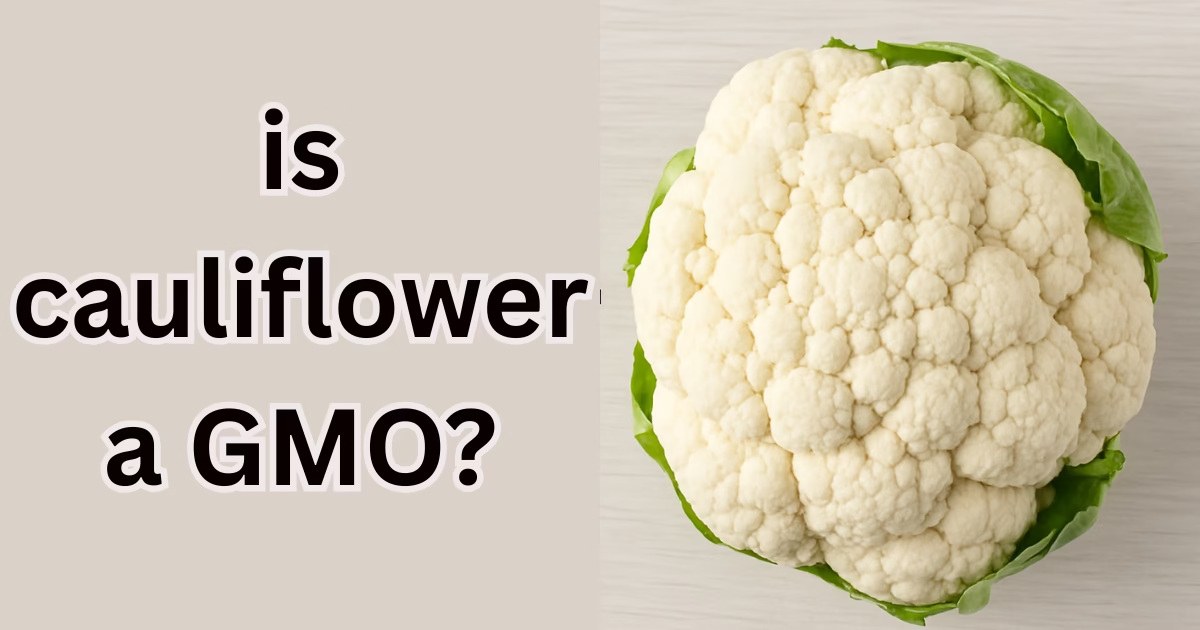When it comes to food, people are getting more cautious—and curious. One question that keeps popping up is: “Is cauliflower a GMO?” With all the talk about genetically modified foods, it’s no surprise that cauliflower often lands in the spotlight. It looks a bit too perfect, right? Big white heads, no seeds, and grows in all seasons. So, naturally, people wonder if it’s been altered in a lab. In this blog, we’re going to explore what GMO actually means and whether cauliflower fits into that category. You’ll learn about how cauliflower was made, if any versions are genetically modified, and what the science says. By the end, you’ll have a clear, fact-based answer to this common food mystery. Spoiler: it might not be what you expect.
What Does “GMO” Really Mean?
The term GMO stands for Genetically Modified Organism. It refers to any living thing—usually plants or animals—that has had its DNA changed using genetic engineering techniques. Scientists insert specific genes into an organism’s DNA to give it new traits. For example, they might add a gene that helps a plant resist pests or survive longer without water.
But here’s the thing—not all modified foods are GMOs. People have been changing plants for thousands of years using traditional methods like selective breeding. That’s where farmers pick the best plants and grow more of them. It’s slower, but it’s totally natural.
So, when talking about GMO foods, we’re talking about modern genetic manipulation done in labs—not just regular farming or cross-breeding. And that’s a major difference to keep in mind as we dive deeper into cauliflower.
Is Cauliflower a GMO?
No, cauliflower is not a GMO. This might surprise some readers, especially since it looks like a vegetable that could have been cooked up in a lab. But cauliflower was actually created through selective breeding, not genetic engineering.
Farmers and botanists worked with a wild plant called Brassica oleracea, the same ancestor as broccoli, cabbage, kale, and Brussels sprouts. Over hundreds of years, they bred it to grow large white flower heads—which is what we now know as cauliflower.
So, while cauliflower is man-made in a way, it doesn’t fall into the GMO category. No scientist inserted genes into its DNA. It was all done the old-fashioned way, by choosing plants with the best traits and breeding them again and again.
The result? A vegetable that looks like it’s from the future but has roots deep in history.
How Was Cauliflower Created?
The story of cauliflower begins with a humble, wild plant. Thousands of years ago, farmers around the Mediterranean region started cultivating Brassica oleracea, a wild mustard plant. They noticed some versions had tighter, tastier flower clusters.
Instead of letting the plants grow naturally, they selected only those with tighter heads and bred them with similar ones. Over time, this selective breeding led to the cauliflower we know today.
Interestingly, the same process gave us broccoli, cabbage, and kale—they all came from the same plant. It just depended on which part of the plant farmers chose to focus on. For cauliflower, it was the flower head.
This method isn’t new or scary. Humans have been doing it for thousands of years to improve flavor, size, and appearance in plants. It’s natural—just with a little help from patient growers.
Are There Any GMO Cauliflower Varieties?
As of now, there are no commercially available GMO cauliflower varieties. That means the cauliflower you see in stores—even the big, white, perfect-looking ones—haven’t been genetically modified in a lab.
Why? For one, cauliflower doesn’t face as many pest or disease issues as crops like corn or soy. Those crops have been genetically modified because they’re grown on a massive scale and often need special resistance traits.
Since cauliflower doesn’t need that kind of help, biotech companies haven’t had much reason to genetically alter it.
So, unless you’re part of a super-secret lab experiment (which you’re probably not), your cauliflower is non-GMO by default.
Is Organic Cauliflower Non-GMO?
Yes, if you’re buying organic cauliflower, you can be sure it’s also non-GMO. In the U.S., the USDA has strict rules. If a food is labeled “organic,” it cannot be genetically modified.
That means organic cauliflower:
- Can’t come from GMO seeds
- Can’t be grown with GMO fertilizers
- Must follow strict natural farming guidelines
So, for people who want to avoid GMOs altogether, organic is a safe choice. Even though regular cauliflower isn’t GMO either, some shoppers just feel better seeing that green organic label.
Just keep in mind—organic doesn’t mean it’s healthier or more nutritious. It just means the way it was grown followed certain rules. Still, for peace of mind, many people stick to organic when it comes to fresh produce.
Common Myths About GMO and Non-GMO Vegetables
There’s a lot of confusion about GMOs, and cauliflower often gets dragged into the mix. Let’s clear a few things up:
Myth 1: All perfect-looking vegetables are GMO
Truth: Many beautiful veggies, like cauliflower, are just selectively bred—not genetically engineered.
Myth 2: If it’s man-made, it’s GMO
Truth: That’s not true. A food can be man-made (through natural breeding) and still be non-GMO.
Myth 3: GMO vegetables are unsafe
Truth: Most research shows GMO foods are just as safe as non-GMO ones. The fear often comes from misinformation or lack of understanding.
Marketing plays a big role in these myths. Some brands slap “non-GMO” on everything—even when the product never had a GMO version to begin with. It’s smart advertising, but it adds to the confusion.
GMO vs. Hybrid vs. Man-Made: What’s the Difference?
Let’s break it down simply:
➤ GMO (Genetically Modified Organism)
Made in a lab. Scientists insert specific genes to create a new trait (like pest resistance).
➤ Hybrid
Two different plant varieties are cross-bred to create a new one. This happens through pollination, not in a lab.
➤ Man-Made (Selective Breeding)
Farmers select and grow only plants with certain traits. Done over generations. Cauliflower falls in this category.
So cauliflower is not a GMO, not a lab hybrid, but a man-made vegetable developed over time using natural methods. That’s an important distinction many people miss.
Should You Be Concerned About Cauliflower Being GMO?
The short answer? No, there’s nothing to worry about.
Cauliflower is not genetically modified, and even if it were, science shows GMOs are safe to eat. The bigger question is why this topic creates so much stress for people.
A lot of it comes from fear. The word “GMO” sounds technical, even scary. But when you peel back the layers, the concern often comes from not knowing the facts.
If you’re someone who feels better avoiding GMO foods, that’s fine. But you can rest easy knowing cauliflower is already non-GMO—whether you buy organic or not.
Also Read: Foods to Boost Stomach Qi: Natural Ways to Improve Digestion & Energy
Final Thoughts: What You Really Need to Know
So, is cauliflower a GMO?
No, it’s not. And never has been.
Cauliflower is the result of natural selective breeding. It’s a man-made vegetable, yes—but not a genetically modified one. That’s an important difference. No lab DNA edits. Just generations of farmers picking the best plants and growing them again and again.
There are no GMO cauliflower varieties being sold today. And if you want extra peace of mind, go with organic—which is always non-GMO by law.
In the end, understanding where your food comes from matters. Not just to eat healthier, but to feel more confident in your choices. Cauliflower might look like something high-tech, but it’s actually a product of ancient farming, not modern science.
So enjoy your next cauliflower dish—with facts on your side.
Faqs
Is cauliflower a GMO?
No, cauliflower is not a GMO. It was created through selective breeding, not genetic modification in a lab.
Is cauliflower man-made?
Yes, cauliflower is man-made through traditional farming methods, but it’s still natural and not genetically engineered.
Are there any GMO cauliflower varieties?
Currently, there are no GMO cauliflower varieties available on the market.
Is organic cauliflower non-GMO?
Yes, by USDA rules, organic cauliflower must be non-GMO.
What is the difference between GMO and selective breeding?
GMO involves lab-based gene editing, while selective breeding is a natural process of choosing plants with desirable traits.

Hi, I’m Shafy Ali – a curious mind and passionate writer at Celiac Magazine. I cover a little bit of everything, from everyday tips and how-tos to deeper dives into topics that spark conversation. I enjoy turning research into readable, relatable content that informs and inspires. Whatever the subject, I aim to keep it clear, engaging, and genuinely useful.

